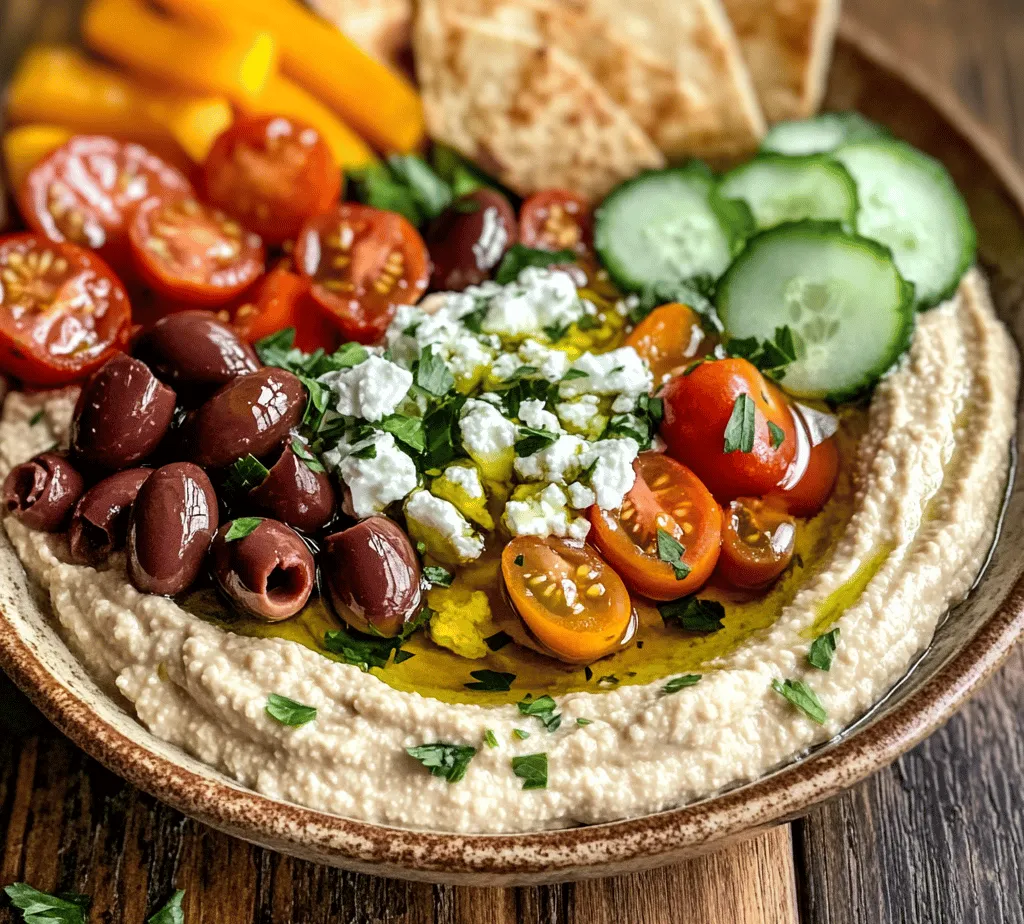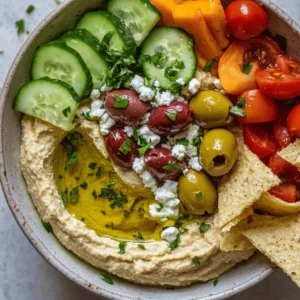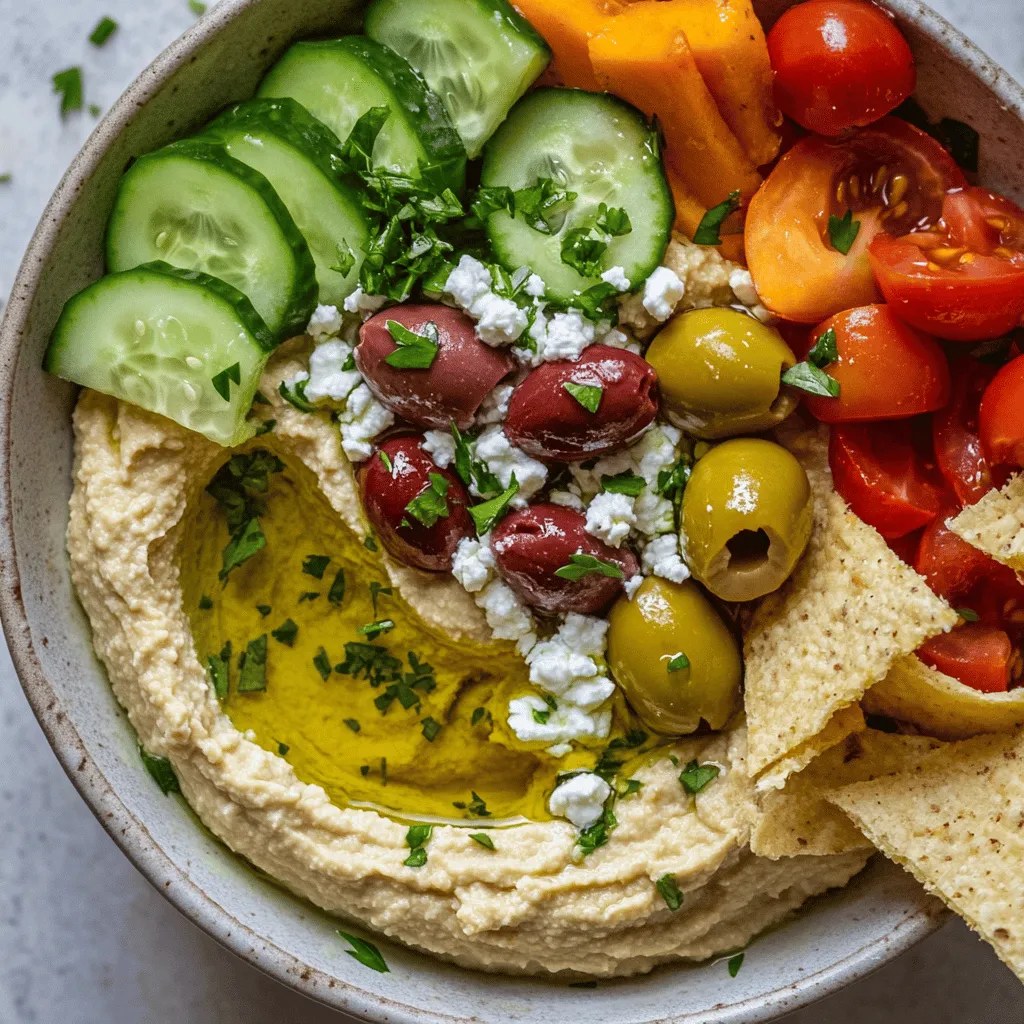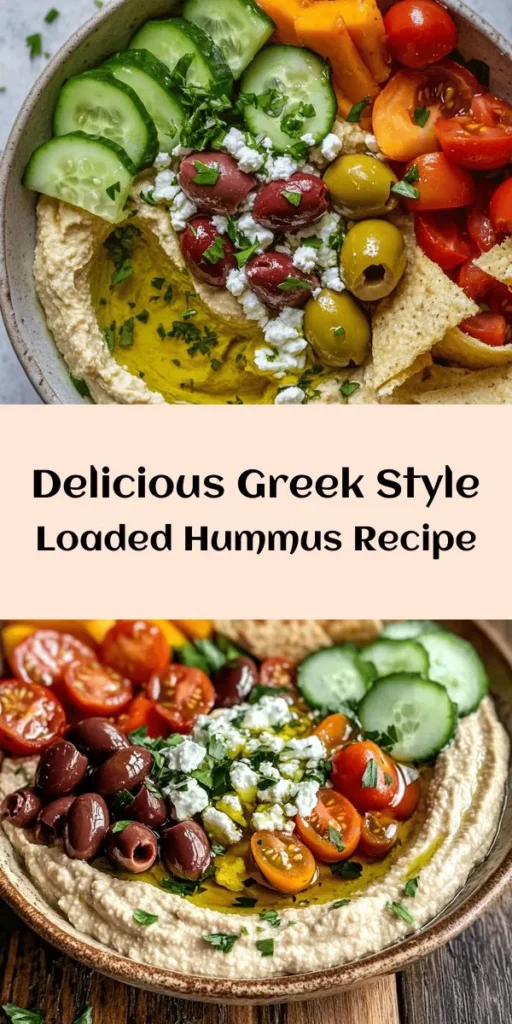Introduction
Greek cuisine is celebrated worldwide for its vibrant flavors, fresh ingredients, and culinary traditions that have been passed down through generations. With its emphasis on vegetables, grains, fish, and healthy fats, Greek food has made a significant mark on the Mediterranean diet, which is renowned for promoting health and longevity. Among the many delicious dishes that originate from this region, hummus stands out as a beloved staple.
Hummus, a creamy chickpea dip blended with tahini, garlic, and lemon juice, is a versatile dish that has become synonymous with Mediterranean cuisine. It is not only enjoyed as a dip but also serves as a spread and a component in various meals. Its popularity has surged globally, making it a go-to appetizer in restaurants and homes alike.
In recent years, a twist on the classic hummus has emerged: loaded hummus. This innovative take elevates the traditional dip into a hearty dish that can serve as a centerpiece for gatherings or a wholesome family meal. The appeal of loaded hummus lies in its customizable nature, allowing you to top it with a variety of fresh ingredients, making it visually stunning and packed with flavor.
What makes Greek Style Loaded Hummus particularly special is its simplicity and the health benefits of its ingredients. With heart-healthy fats, protein-rich components, and a plethora of vitamins and minerals, this dish not only satisfies the palate but also nourishes the body.
The Appeal of Greek Style Loaded Hummus
The flavor profile of Greek Style Loaded Hummus is a delightful combination of creaminess, tanginess, and freshness. The base of smooth hummus is complemented by an array of vibrant toppings, creating a dish that is as pleasing to the eye as it is to the taste buds. The richness of tahini and Greek yogurt mingles beautifully with the brightness of lemon juice and the earthiness of chickpeas, while the toppings—crunchy vegetables, briny olives, and creamy feta—add layers of texture and flavor.
One of the most significant advantages of hummus is its versatility. It can be served as an appetizer, a snack, or even as a main dish, depending on how it is presented. At gatherings, loaded hummus can be the star of a mezze platter, inviting guests to dip pita bread or fresh vegetables into the rich, flavorful base. Alternatively, it can be enjoyed as a quick and healthy lunch, topped with a colorful array of vegetables and proteins.
Nutritionally, Greek Style Loaded Hummus is a powerhouse. The primary ingredient, chickpeas, is a fantastic source of plant-based protein and fiber, promoting digestive health and satiety. Tahini, made from ground sesame seeds, is rich in essential fatty acids and provides a creamy texture. Extra virgin olive oil, a staple in Greek cooking, is known for its heart-healthy monounsaturated fats and antioxidants. Garlic adds not only flavor but also potential health benefits, including anti-inflammatory properties and immune support.
The addition of lemon juice brings acidity and freshness, enhancing the overall taste of the dish. Ground cumin contributes warmth and an aromatic quality that complements the other flavors beautifully. Greek yogurt adds a creamy richness and extra protein, while vegetables like cucumbers and cherry tomatoes introduce a satisfying crunch and vibrant color. Kalamata olives and feta cheese provide a briny bite and creaminess that rounds out the dish, making it irresistible.
Culturally, hummus holds a significant place in Greek and Mediterranean traditions. It has been enjoyed for centuries and is often associated with hospitality and sharing. Whether served at family dinners or festive gatherings, hummus symbolizes togetherness and the joy of sharing good food with loved ones.
Ingredients Breakdown
Understanding the ingredients that make up Greek Style Loaded Hummus is key to appreciating its flavor and nutritional benefits. Each component contributes uniquely to the overall dish, creating a harmonious blend of tastes and textures.
Chickpeas
Chickpeas, also known as garbanzo beans, serve as the base of hummus. These legumes are a fantastic source of plant-based protein, containing about 15 grams of protein per cooked cup. They are also high in fiber, which aids digestion and helps maintain a healthy weight. Chickpeas are rich in vitamins and minerals, including folate, iron, and magnesium, making them an essential part of a balanced diet. In hummus, they provide a smooth, creamy texture when blended, forming the perfect foundation for this delicious dish.
Tahini
Tahini is a paste made from ground sesame seeds and is a key ingredient in hummus. It contributes a rich, nutty flavor that enhances the overall taste of the dish. Beyond its flavor, tahini is packed with health benefits; it is rich in healthy fats, particularly monounsaturated fats, which are known to support heart health. Additionally, tahini is a great source of calcium, magnesium, and zinc, which are essential for bone health and immune function. Its creamy consistency adds to the smooth texture of hummus, making it incredibly satisfying.
Extra Virgin Olive Oil
In Greek cuisine, the quality of olive oil is paramount. Extra virgin olive oil, made from the first pressing of olives, is known for its robust flavor and numerous health benefits. It is high in antioxidants and monounsaturated fats, which can help reduce inflammation and lower the risk of chronic diseases. The richness of extra virgin olive oil enhances the flavor of hummus and adds a luxurious mouthfeel. A drizzle over the top of loaded hummus not only elevates the presentation but also enriches the overall taste experience.
Garlic
Garlic is a staple in Mediterranean cooking, prized for its bold flavor and numerous health benefits. It contains compounds that may boost the immune system and promote heart health by reducing blood pressure and cholesterol levels. In hummus, garlic provides a sharp, savory note that balances the creaminess of tahini and yogurt. The amount of garlic can be adjusted based on personal preference, allowing for a customizable flavor profile.
Lemon Juice
Lemon juice is an essential ingredient in hummus, adding brightness and acidity that uplift the dish. The refreshing tang of lemon juice enhances the flavors of the other ingredients, creating a well-rounded taste. Additionally, lemons are a great source of vitamin C, which plays a crucial role in immune function and skin health. The acidity from lemon juice is key to achieving the perfect balance in hummus, making it a refreshing dip that is perfect for any occasion.
Ground Cumin
Ground cumin is a spice commonly used in Mediterranean and Middle Eastern cuisines, known for its warm, earthy flavor. It adds depth and complexity to hummus, complementing the other flavors beautifully. Cumin is also associated with various health benefits, including aiding digestion and possessing antioxidant properties. Its aromatic qualities make it a perfect addition to this Greek Style Loaded Hummus, enhancing the overall flavor profile.
Greek Yogurt
Greek yogurt is an excellent addition to hummus, providing creaminess and a boost of protein. It is thicker and creamier than regular yogurt, which contributes to a luscious texture. Greek yogurt is also rich in probiotics, which support gut health and digestion. The tanginess of Greek yogurt complements the flavors of the other ingredients, adding a refreshing note to the dish. This ingredient is what makes Greek Style Loaded Hummus exceptionally rich and satisfying.
Vegetables (Cucumber, Cherry Tomatoes)
Fresh vegetables are not only a visual delight but also add crunch and nutrition to loaded hummus. Cucumbers are crisp and refreshing, providing hydration and essential vitamins. They are low in calories, making them a perfect addition to this healthy dish. Cherry tomatoes add a pop of sweetness and color, contributing antioxidants like lycopene, which are beneficial for heart health. Together, these vegetables enhance the flavor, texture, and nutritional value of the hummus.
Kalamata Olives
Kalamata olives are a staple in Greek cuisine, known for their rich, fruity flavor and dark color. They contribute a briny, salty element that enhances the overall taste of loaded hummus. Olives are a good source of healthy fats and antioxidants, making them a nutritious addition to this dish. Chopping them up and sprinkling them over the hummus adds a burst of flavor and a pleasing contrast to the creaminess of the dip.
Feta Cheese
Feta cheese is a quintessential Greek ingredient that adds a creamy, tangy flavor to loaded hummus. Its crumbly texture and salty taste complement the other toppings beautifully. Feta is also a source of protein and calcium, contributing to the dish’s nutritional benefits. The addition of feta cheese not only enhances the flavor but also adds visual appeal with its white color contrasting against the vibrant vegetables.
With these ingredients, you are well on your way to creating a delightful Greek Style Loaded Hummus that will impress your family and friends. The next section will detail the step-by-step instructions to prepare this delicious dish, ensuring that you achieve the best results. Stay tuned for more insights and tips on making this Mediterranean masterpiece!

Fresh Parsley: Garnish and Flavor Balance
Fresh parsley is not just a garnish; it’s a vital component that enhances the overall flavor profile of Greek Style Loaded Hummus. Its bright, slightly peppery taste complements the rich creaminess of the hummus and the savory toppings. When using fresh parsley, opt for flat-leaf parsley for its robust flavor. Chop it finely and sprinkle it generously over your assembled dish for a burst of color and freshness. Not only does it elevate the taste, but it also adds a nutritional boost, packed with vitamins A, C, and K.
Pita Chips and Vegetables: Serving Suggestions
When it comes to serving Greek Style Loaded Hummus, the options are endless. The classic pairing is pita chips, which offer a satisfying crunch that perfectly contrasts the creamy texture of the hummus. You can easily make your own pita chips by cutting pita bread into triangles, brushing them with olive oil, and baking them until golden and crisp.
For a healthier alternative, consider an array of fresh vegetables. Carrot sticks, cucumber slices, bell pepper strips, and cherry tomatoes not only add a vibrant splash of color but also provide a refreshing bite. This combination of dippers makes for a visually appealing presentation that encourages guests to indulge in the dish.
Step-by-Step Instructions to Prepare Greek Style Loaded Hummus
Preparing the Base Hummus
To create a delicious Greek Style Loaded Hummus, you’ll first need to prepare the base. Start with high-quality chickpeas; you can use canned or dried. If using dried chickpeas, soak them overnight and boil until tender. If you’re using canned chickpeas, simply drain and rinse them well to remove excess sodium.
In a food processor, add the chickpeas, tahini, garlic, lemon juice, olive oil, and a pinch of salt. Blend until the mixture is smooth. If it’s too thick, add a tablespoon of water at a time until you achieve your desired consistency.
Combining Ingredients in the Food Processor
Once the base hummus is smooth, it’s time to add the additional flavors that make this dish special. Incorporate ingredients like ground cumin and sun-dried tomatoes, blending them into the hummus until well combined. This is where the magic happens; the spices infuse the hummus with depth and complexity.
Tips for Achieving the Perfect Consistency
Achieving the perfect hummus consistency is key to a successful dish. If you prefer a creamier texture, consider adding more tahini or olive oil. For a lighter hummus, increase the water or lemon juice. Remember to blend the mixture thoroughly, scraping down the sides of the food processor to ensure all ingredients are incorporated evenly.
Flavor Adjustments and Seasoning
Taste your hummus before serving. This is the perfect time to adjust flavors. If you find it lacks brightness, add an extra splash of lemon juice. If it needs more depth, consider a touch of smoked paprika or a dash of cayenne pepper for heat. These flavor adjustments will elevate your hummus from good to great.
Balancing Flavors with Salt, Pepper, and Lemon Juice
Salt is essential for enhancing flavors, but be cautious not to overdo it. Start with a small amount, blend, and taste. The same goes for pepper; fresh cracked black pepper can add an aromatic touch. Lemon juice not only brightens the flavors but also acts as a natural preservative, so don’t shy away from it.
Assembly of the Loaded Dish
With your hummus prepared, it’s time to assemble the loaded dish. Spread a generous layer of hummus onto a serving platter or shallow bowl. Use the back of a spoon to create swirls and indentations for the toppings to sit in.
Spreading the Hummus and Layering Toppings
Now comes the fun part: layering your toppings. Start with a base of diced cucumbers, cherry tomatoes, and Kalamata olives. Next, sprinkle crumbled feta cheese and finely chopped red onion for added flavor. For a final touch, drizzle a bit of olive oil over the top, which will enhance the visual appeal and add richness.
Visual Presentation Tips for an Appealing Dish
Presentation matters. For a beautiful display, use a variety of colors in your toppings. Arrange them in sections or create a colorful mosaic effect. Garnishing with fresh parsley not only adds a pop of green but also makes the dish look fresh and inviting. A sprinkle of paprika or a few whole olives can also enhance the overall visual appeal.
Serving Suggestions
Ideal Pairings with Pita Chips and Fresh Vegetables
The beauty of Greek Style Loaded Hummus is its versatility. Serve it with crispy pita chips for a classic appetizer or offer a platter of fresh vegetables for a lighter option. The contrast in textures will delight your guests and make for a satisfying snack or meal.
Other Ways to Enjoy Loaded Hummus
Greek Style Loaded Hummus is not just limited to being a dip. It can be used as a flavorful spread in sandwiches or wraps, adding a creamy element to your favorite ingredients. Alternatively, consider using it as a topping for salads, where it can serve as a protein-rich component, bringing together the flavors of Mediterranean cuisine.
Suggestions for Garnishing and Serving Style
To elevate your serving style, consider presenting your hummus in a rustic wooden bowl or a colorful ceramic dish. Use fresh herbs like thyme or dill for garnishing, and offer a selection of dippers arranged neatly around the dish. This will entice your guests and encourage them to dive into the delicious flavors.
Storage and Shelf Life
Best Practices for Storing Leftover Hummus
If you have any leftover Greek Style Loaded Hummus, store it in an airtight container in the refrigerator. To keep it fresh, drizzle a thin layer of olive oil on top before sealing. This helps prevent the hummus from drying out and maintains its creamy texture.
How to Keep the Toppings Fresh
To keep toppings fresh, store them separately in airtight containers. This prevents them from wilting or losing their crunch. When ready to serve again, simply reassemble the dish for a fresh look and taste.
Discussion on the Shelf Life of Homemade vs. Store-Bought Hummus
Homemade hummus generally has a shorter shelf life than store-bought versions due to the absence of preservatives. Typically, homemade hummus can last about 4 to 7 days in the refrigerator if stored properly. In contrast, store-bought hummus can last for several weeks when unopened. However, once opened, it should also be consumed within a week for the best flavor and freshness.
Conclusion
Greek Style Loaded Hummus is a delightful combination of flavors and textures that comes together with ease. Its simplicity makes it an ideal dish for gatherings, family meals, or as a healthy snack. The health benefits are abundant, with chickpeas providing protein and fiber, while the variety of fresh toppings adds vitamins and minerals.
Exploring Mediterranean recipes like this one opens a door to diverse culinary traditions, inviting you to appreciate the cultural significance behind each dish. Whether enjoyed as a dip, spread, or salad topping, this loaded hummus is sure to impress and satisfy your taste buds. Embrace the flavors and health benefits, and let Greek Style Loaded Hummus become a staple in your kitchen.



